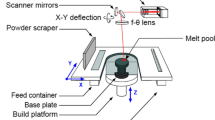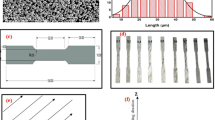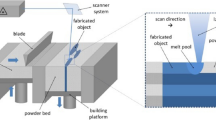Abstract
In this study, process parameter optimization was performed for the powder bed fusion of H13 tool steel under low- (400 W) and high-power (1000 W) conditions using the SLM 280HL machine. The effects of process parameters such as the laser power, scan speed, and hatching pitch on the density and microstructure of the as-built H13 tool steel were investigated. The specimen density was found to be slightly lower under the high-power condition than that under the low-power condition. Electron backscattering diffraction analysis identified that the as-built specimens showed a prolonged columnar microstructure in the build direction under the low-power condition. In contrast, for the specimens fabricated using the hull-core method under the high-power condition, the hull and core parts showed prolonged columnar and equiaxed microstructures, respectively. Phase distribution images indicated that the microstructures of the as-built specimens under the low- and high-power conditions contained martensite (bcc) and austenite (fcc) with a grain size of approximately 1 μm. Thus, it was found that the specimen density achieved using the 400-W laser is higher than that achieved using the 1000-W laser; moreover, the microstructure of the as-built specimen using the 400-W laser is different from that using the 1000-W laser.













Similar content being viewed by others
References
Bourell D, Kruth JP, Leu M, Levy G, Rosen D, Beese AM, Clare A (2017) Materials for additive manufacturing. CIRP Ann Manuf Technol 66:659–681
Debroy T, Wei HL et al (2018) Additive manufacturing of metallic components – process, structure and properties. Prog Mater Sci 92:112–224
Niu HJ, Chang ITH (1998) Liquid phase sintering of M3/2 high speed steel by selective laser sintering. Scr Mater 39:67–72
Niu HJ, Chang ITH (1999) Selective laser sintering of gas and water atomized high speed steel powders. Scr Mater 41:25–30
Asgharzadeh H, Simchi A (2005) Effect of sintering atmosphere and carbon content on the densification and microstructure of laser-sintered M2 high-speed steel powder. Mater Sci Eng A 403:290–298
Xie JW, Fox P, O’Neill W, Sutcliffe CJ (2005) Effect of direct laser re-melting processing parameters and scanning strategies on the densification of tool steels. J Mater Process Technol 170:516–523
Kempen K, Vrancken B et al (2014) Selective laser melting of crack-free high density M2 high speed steel parts by baseplate preheating. J Manuf Sci Eng 136:061026
Zhang M, Chen C et al (2018) Laser additive manufacturing of M2 high-speed steel. Mater Sci Technol 34:69–78
Mazur M, Leary M et al (2016) SLM additive manufacture of H13 tool steel with conformal cooling and structural lattices. Rapid Prototyp J 22(3):504–518
Mazur M, Brincat P, Leary M, Brandt M (2017) Numerical and experimental evaluation of a conformally cooled H13 steel injection mould manufactured with selective laser melting. Int J Adv Manuf Technol 93:881–900
Yakout M, Cadamuro A, Elbestawi MA, Veldhuis SC (2017) The selection of process parameters in additive manufacturing for aerospace alloys. Int J Adv Manuf Technol 92:2081–2098
Fayazfar H, Salarian M, Rogalsky A, Sarker D, Russo P, Paserin V, Toyserkani E (2018) A critical review of powder-based additive manufacturing of ferrous alloys: process parameters, microstructure and mechanical properties. Mater Des 144:98–128
Malý M, Höller C, Skalon M, Meier B, Koutný D, Pichler R, Sommitsch C, Paloušek D (2019) Effect of process parameters and high-temperature preheating on residual stress and relative density of Ti6Al4V processed by selective laser melting. Materials 12:930. https://doi.org/10.3390/ma12060930
Vock S, Klöden B, Kirchner A, Weißgärber T, Kieback B (2019) Powders for powder bed fusion: a review. Prog Addit Manuf 4:383–397
Narvan M, Al-Rubaie KS, Elbestawi M (2019) Process-structure-property relationships of AISI H13 tool steel processed with selective laser melting. Materials 12:2284. https://doi.org/10.3390/ma12142284
Laakso P, Riipinen T et al (2016) Optimization and simulation of SLM process for high density H13 tool steel parts. Phys Procedia 83:26–35
Holzweissig MJ, Taube A, Brenne F, Schaper M, Niedorf T (2015) Microstructural characterization and mechanical performance of hot work tool steel processed by selective laser melting. Metall Mater Trans B 46B:545–549
Mertens R, Vrancken B et al (2016) Influence of powder bed preheating on microstructure and mechanical properties of H13 tool steel SLM parts. Phys Procedia 83:882–890
Krell J, Röttger A, Geenen K, Theisen W (2018) General investigations on processing tool steel X40CrMoV5-1 with selective laser melting. J Mater Process Technol 255:679–688
Wang M, Li W et al (2019) High-temperature properties and microstructural stability of the AISI H13 hot-work tool steel processed by selective laser melting. Metall Mater Trans B 50B:531–542
Yan JJ, Zheng DL et al (2017) Selective laser melting of H13: microstructure and residual stress. J Mater Sci 52:12476–12485
Casati R, Coduri M et al (2018) Microstructure and mechanical behavior of hot-work tool steels processed by selective laser melting. Mater Charact 137:50–57
Prudente WR, Fabrício CLJ et al (2017) Microstructural evolution under tempering heat treatment in AISI H13 hot-work tool steel. Int J Eng Res Appl 7:67–71
Sander J, Hufenbach J et al (2016) Microstructure and properties of FeCrMoVC tool steel produced by selective laser melting. Mater Des 89:335–341
Boes J, Röttger A, Mutke C, Escher C, Theisen W (2018) Microstructure and mechanical properties of X65MoCrWV3-2 cold-work tool steel produced by selective laser melting. Addit Manuf 23:170–180
Åsberg M, Fredriksson G, Hatami S, Fredriksson W, Krakhmalev P (2019) Influence of post treatment on microstructure, porosity and mechanical properties of additive manufactured H13 tool steel. Mater Sci Eng A 742:584–589
King WE, Barth HD et al (2014) Observation of keyhole-mode laser melting in laser powder-bed fusion additive manufacturing. J Mater Process Technol 214:2915–2925
King WE, Anderson T et al (2015) Overview of modelling and simulation of metal powder bed fusion process at Lawrence Livermore National Laboratory. Mater Sci Technol 31:957–968
Qiu C, Panwisawas C, Ward M, Basoalto HC, Brooks JW (2015) On the role of melt flow into the surface structure and porosity development during selective laser melting. Acta Mater 96:72–79
Khairallah SA, Anderson AT, Rubenchik AM, King WE (2016) Laser powder-bed fusion additive manufacturing: physics of complex melt flow and formation mechanisms of pores, spatter, and denudation zones. Acta Mater 108:36–45
Matthews MJ, Guss G et al (2016) Denudation of metal powder layers in laser powder bed fusion processes. Acta Mater 114:33–42
Martin AA, Calta NP et al (2019) Dynamics of pore formation during laser powder bed fusion additive manufacturing. Nat Commun 10:1987. https://doi.org/10.1038/s41467-019-10009-2
Cunningham R, Zhao C et al (2019) Keyhole threshold and morphology in laser melting revealed by ultrahigh-speed x-ray imaging. Science 363:849–852
Kyogoku H, Ikeshoji T-T (2020) A review of metal additive manufacturing technologies: mechanism of defects formation and simulation of melting and solidification phenomena in laser powder bed fusion process. Mech Eng Rev 7(1):19–00182
Araki M, Kusaka S et al (2018) Parameter optimization on the fabrication of Al-10Si-0.4Mg alloy using selective laser melting process. J Jpn Soc Powder Powder Metallurgy 65:383–388
Tachibana Y, Ikeshoji T-T, Nakamura K, Yonehara M, Kyogoku H (2018) Selective laser melting of Inconel 718 under high power and high scanning speed conditions. Mater Sci Forum 941:1574–1577
Ikeshoji T-T, Nakamura K, Yonehara M, Imai K, Kyogoku H (2018) Selective laser melting of pure copper. JOM 70:396–400
Calleja A, Tabernero I et al (2014) Feed rate calculation algorithm for the homogeneous material deposition of blisk blades by 5-axis laser cladding. Int J Adv Manuf Technol 74:1219–1228
Yeung H, Lane B, Fox J (2019) Part geometry and conduction-based laser power control for powder bed fusion additive manufacturing. Addit Manuf 30:100844
Martínez S, Lamikiz A et al (2017) Analysis of the regimes in the scanner-based laser hardening process. Opt Lasers Eng 90:72–80
Valente EH, Gundlach C et al (2019) Effect of scanning strategy during selective laser melting on surface topography, porosity, and microstructure of additively manufactured Ti-6Al-4V. Appl Sci 9:5554. https://doi.org/10.3390/app9245554
Niendorf T, Leuders S et al (2013) Highly anisotropic steel processed by selective laser melting. Metall Mater Trans B 44B:749–796
Author information
Authors and Affiliations
Corresponding author
Additional information
Publisher’s note
Springer Nature remains neutral with regard to jurisdictional claims in published maps and institutional affiliations.
Rights and permissions
About this article
Cite this article
Yonehara, M., Ikeshoji, TT., Nagahama, T. et al. Parameter optimization of the high-power laser powder bed fusion process for H13 tool steel. Int J Adv Manuf Technol 110, 427–437 (2020). https://doi.org/10.1007/s00170-020-05879-6
Received:
Accepted:
Published:
Issue Date:
DOI: https://doi.org/10.1007/s00170-020-05879-6




